“Délivrance” is the name I gave to “Retraceur” very first stable version. Indeed, as I told you in mid-January, this fork of the famous online publishing platform whose trademark belongs to Mr. Mullenweg is the solution I imagined and implemented to continue enjoying my hobby while remaining faithful to the values and ethics I hold dear.
I took advantage of my changes to break away from dependencies on Mullenweg-controlled sites and resources to greatly lighten the software and make it focus on the essentials: helping individuals, like myself, in building and fully mastering a personal hub of their online publications.
Today, I’m releasing the results of this “re-tracing” so that you can benefit from my investment if you share the same vision, requirements and needs as me.
Set free and empowered
By breaking the multiple links weaved by the emperor of the “MullenWeb” our Websites were trapped in for more than 20 years, we are taking back our independence. With this new-found freedom comes a huge responsibility: to keep our Websites secure, operational and evolving without the many facilities we enjoyed while in captivity.
Independence and vigilance
Powered by “Retraceur”, our Websites no longer send regular requests to the api.wordpress.org URI, thus avoiding the transmission of interesting data to Mr. Mullenweg’s datacenter (such as the URL of our Websites, the number of users of our Websites, the language of our Websites, the versions of PHP and MySQL as well as the operating system of our Web servers, etc.) to help him figure out which domains are using the software and how.
The downside of it is… Our Websites no longer receive the very useful requests replies:
- the availability of the software, its extensions and themes new versions,
- the software, its extensions and themes updates download and installation,
- the software, its extensions and themes translation updates download and installation.
So, our independence is first and foremost coming at the price of this temporary loss of (semi)-automated updating mechanisms for the core of our Websites. While we await for the 2nd “Retraceur” major version, it’s essential to stay tuned of software new versions by subscribing to its Bluesky or GitHub feeds; and when a new version is available, to install it manually. Apart from those of us who have always preferred to disable these mechanisms, it’s a 13-year step back in time that’s worth refreshing our memories on the important steps involved in a successful manual upgrade.
When it comes to updating the third-party resources we might install to customize or extend “Retraceur”, the manual operation of replacing our plugin or theme folder with the updated one can be shortened thanks to the Zip archive loading feature built into our Website’s administration interface.
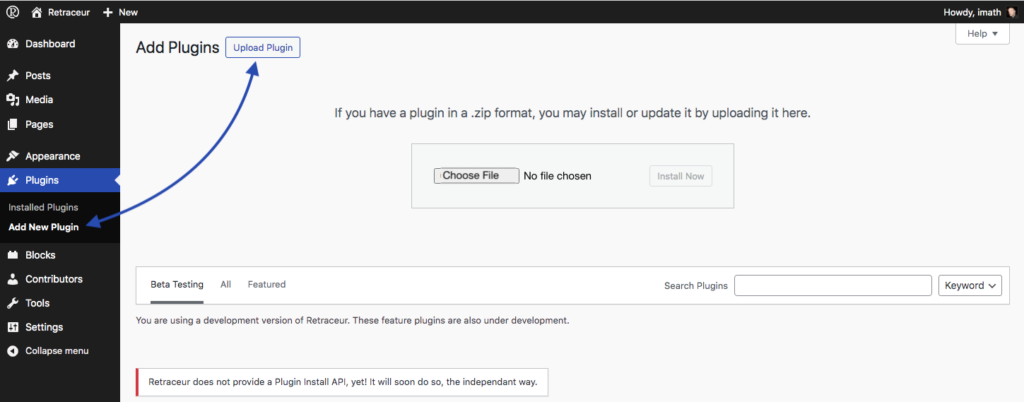
At the bottom of the screenshot above, an administration notice reminds us that the discovery of these third-party extension or customization resources is not currently interfaced with our site administration. As of the “Retraceur” 2.0 version, plugins, blocks or themes that declare a dependency on the software will be discoverable from these administration screens. By the way, authors of such resources wishing to reference them in these screens in the near future can find out about the settings to be made from this ticket in the main “Retraceur” GitHub repository.
We’re all contributors
As I am the project’s only human resource for now, I may rapidly run out of capacity to support the software, should you and other users choose the alternative way drawn by “Retraceur”. My advice: take it only if you’re not afraid to get your hands dirty and contribute to the ongoing improvement of the personal hub of our online publications.
Choosing “Retraceur” is a demanding choice, as it forces us to position ourselves directly as contributors to the open-source project that drives its maintenance and evolution.
This role requires us to act in an exemplary way, upholding the highest ethical standards and respecting our code of conduct, both in our work to improve the software and in the way we use it for our Internet presence.
A “Retraceur” contributor is a good open-source citizen who participates actively, positively, respectfully and benevolently in the project and, more generally, in the free and open-source software community, in a spirit of mutual aid and sharing.
Contributing to “Retraceur” concretely implies :
- embracing and promoting the values of openness, inclusion, equality, neutrality, continuity, transparency, responsibility and adaptability;
- preferring the general interest to individual profit;
- being driven by a mindset of sobriety and continuous improvement;
- to respect open-source licenses and correctly attribute credits to other contributors;
- to help write or improve documentation to make the project accessible to as many people as possible, especially new contributors;
- participate in beta-testing periods by reporting bugs and describing them in a clear and useful way;
- contribute to the code by submitting improvements or fixes for this project or other projects declaring a dependency on “Retraceur”;
- systematically include a resolution suggestion to bug reports;
- to make sure to report or get help via the tools offered by “Retraceur” in order to avoid creating confusion with those of Mr. Mullenweg’s platform, its extensions or themes;
- to interact respectfully in discussions, whether on forums, reporting tools or pull requests;
- to help beginners integrate by guiding them, explaining how to contribute and encouraging them to participate in open-source projects.
Truly free and open
While this first release does not yet compensate for the abrupt removal of our dependency to automatic upgrades or plugins & themes directory services, all other dependencies controlled by Mr. Mullenweg have been replaced:
- Libravatar: is the free and open service that centralizes the supply of profile images for members of our websites. It replaces Automattic’s Globally Recognized Avatars (gravatars) service.
- OpenMoji: is the open source emoji library that replaces the WP Emojis hosted on
api.w.org. - The GitHub repository of “Retraceur” resources provides schema files for all blocks and block themes to replace
schemas.wp.org. - wsrv, a free and open-source image caching tool, takes care of delivering remote images previously provided from
api.w.org. - The REST API action URIs used to control users’ ability to perform certain tasks in the block editor are now pointing to real URLs on the “Retraceur” documentation site.
Lightened and“authen-ethical”,“Retraceur” core is cleaner and it got rid of outdated features
Once the moorings of the “MullenWeb” had been unhooked and the many instances of the W trademark – now tarnished by its owner’s lack of ethics – had been removed, I realized that the source code was also weighed down with ballast: functionalities that were outdated or superfluous in relation to the new path I was drawing up.
As “Retraceur” vocation is to offer a modern solution for organizing the our online publications hub, I began by moving Sites Network management and comments/trackbacks to features as plugins. About comments, my long-term ambition is to make the feature inherit from a more generic API for interaction with any post type.
A modern writing and customization experience
I then set about clearing out obsolete or soon-to-be obsolete code, basing my choices on a forward-looking / evolutions-first principle. “Retraceur” takes a block-based approach to its functionalities: content editing is exclusively handled via block manipulation, the default and native theme is based on block templates, while block customization is managed from the site’s block editor.
As a result, the classic editor code, the ancestral Widget management, the Customizer tool and the prehistoric menus has disappeared from the software and are completely deprecated.
Bye-bye outdated features and APIs
What I compare to blogroll: the management of external links and bookmarks, the XML/RPC API and the ability to publish content by e-mail have been removed.
Contributor by default
The roles have been simplified and are in line with my conviction that humans can no longer merely use or consume in the various environments in which they evolve: they must commit to them, take care of them and contribute to their maintenance, while also caring of humans who will succeed them.
“Retraceur” natively offers two roles to our websites members: administrator or contributor. This means that any new registration to our sites gives the member a duty to contribute.
If you disagree with my opinion and prefer to keep all the roles provided by the software whose trademark belongs to Mr. Mullenweg, you can add the definition of a constant define( 'USE_DEFAULT_WP_ROLES', true ) to your wp-config.php file once it has been generated during the installation process and just before launching the database setup (end of step 3).
First “re-tracings”
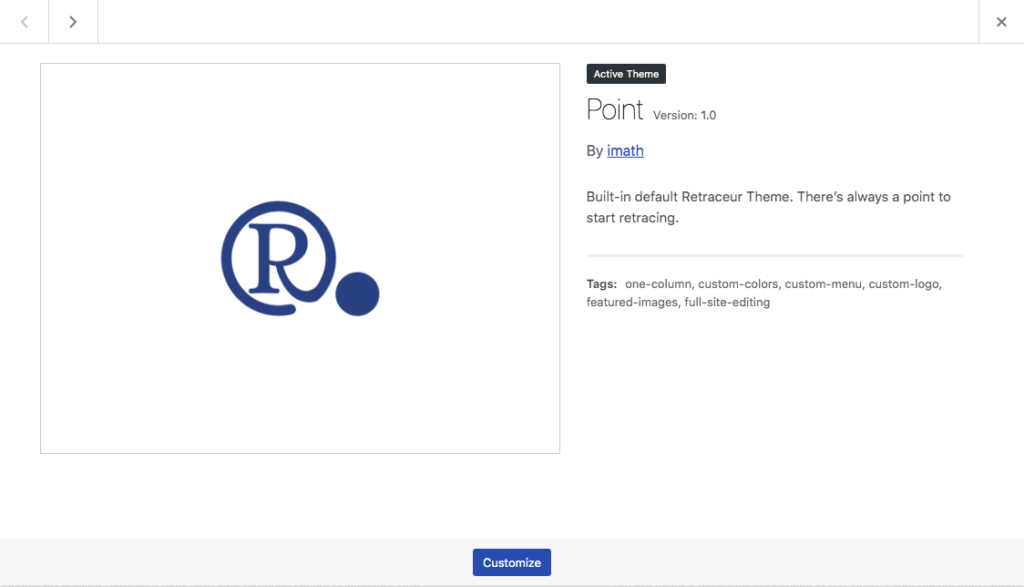
Point, the“Retraceur” default theme
Bundled with “Retraceur” core, Point is a minimalist, block-based theme. It features a single column layout, no sidebar, and a unique navigation positioned at the very top of your web pages. The best way to discover it is to browse this site, where it is activated.
Third-party blocks now have their own dedicated administration area
Of course, blocks are packaged as plugins and are installed in the /wp-content/plugins directory of our sites. However, their management in our dashboards deserves to be isolated from the regular plugins one, especially as “Retraceur” plans to build a block directory to browse and install the magnificent creations proposed by the next “Retraceur” contributors.
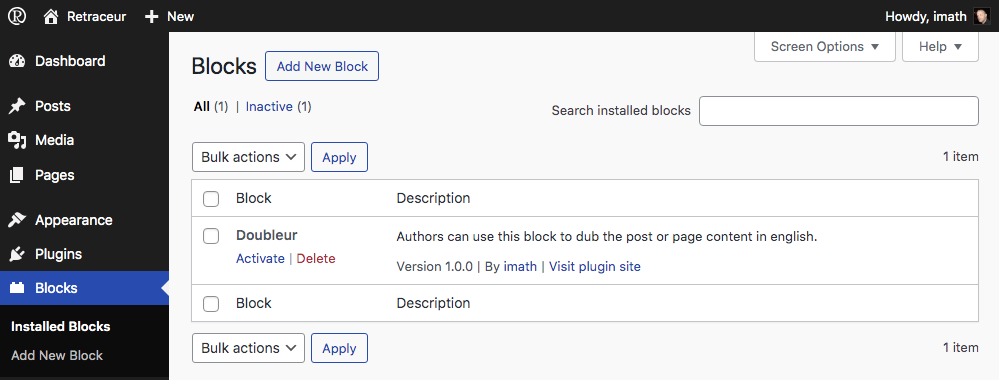
Under the hood, “Retraceur” differentiates two plugin types: classic ones and those that are actually blocks. If you’re planning to develop “Retraceur” blocks, you should know that this differentiation is achieved by adding a new tag to your block’s main file: Plugin Type: block. The Doubleur block I recently shared with you may serve as inspiration on how to add this label.
The registration process only creates contributors once their account has been validated
By default, “Retraceur” doesn’t allow our visitors to join and become more involved in their contribution to our sites. If, however, you wish to give them this possibility, you can activate the corresponding option in the membership settings of your “Retraceur” dashboard.

Once this option has been applied, the login page to our sites will contain a registration link which, when clicked by a visitor, will init the process described below.
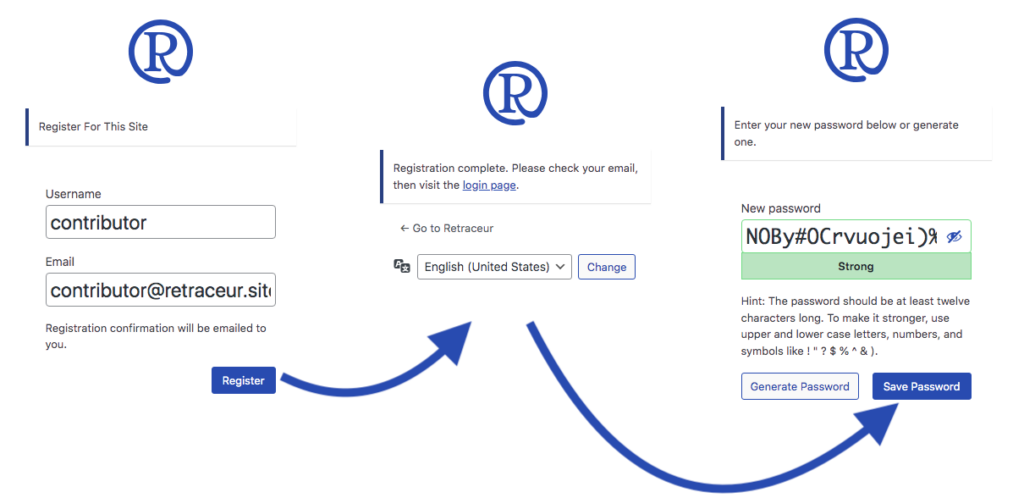
First, he/she chooses a login and enters his/her e-mail address. Once the form has been validated, “Retraceur” sends an e-mail containing a unique activation link to the visitor. When the visitor clicks on it, he/she sets his/her password, and only then the membership is stored into the database.
A contribution account must be self-managed
Unlike software whose trademark is owned by Mr. Mullenweg, “Retraceur” believes that members of our sites have the right to leave them without having to ask an administrator for permission.

Their profile administration includes a danger zone from which they can directly delete their account.

To avoid awkward clicks, a confirmation screen is displayed to confirm this decision.
Should you switch to “Retraceur” to free yourself from the MullenWeb?
I personally dumped all the content from my old site to create a brand new Internet presence. Starting from scratch is actually the simplest way to switch, since all you have to do is to follow these installation steps to be sure that all the elements of “Retraceur” are at the right place.
If you need to get rid of the web woven by Mr. Mullenweg while keeping your old content, it’s relatively simple when your original configuration is standard and relies on a block-based theme: simply upgrade to “Retraceur” by following these steps.
f you’re thinking about switching from a Multisite configuration, I strongly advise you forget about “retracing“ your site for now: as you may have read earlier, this specific configuration is not natively supported by “Retraceur”, and the plugin that will make it possible to build a Sites network is not yet available.
If you activated plugins or a theme using features which vanished from “Retraceur”, don’t switch!
You should always check your Plugins & Themes administration screens to figure out whether their authors tested them with “Retraceur”, if it’s not the case: systematically take the precaution of testing your combination of third-party resources locally.
Finally, remember: choosing “Retraceur” is a demanding choice, as it forces us to position ourselves directly as contributors to the open-source project that drives its maintenance and evolution. Click on the button below only if you’re ready to get your hands dirty!

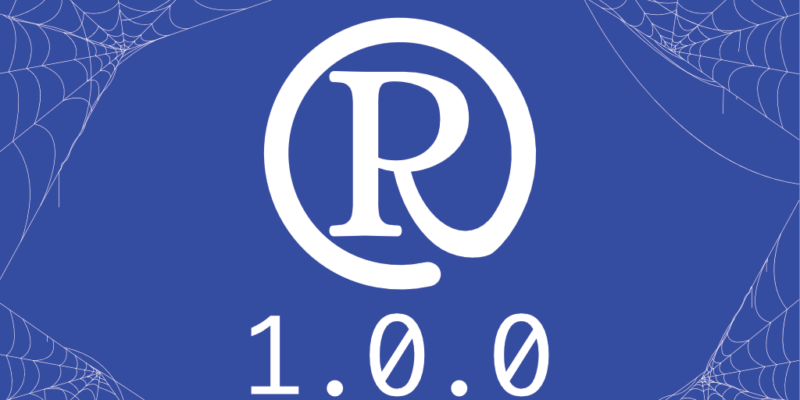
Conversation
Rejoignez la conversation depuis Bluesky